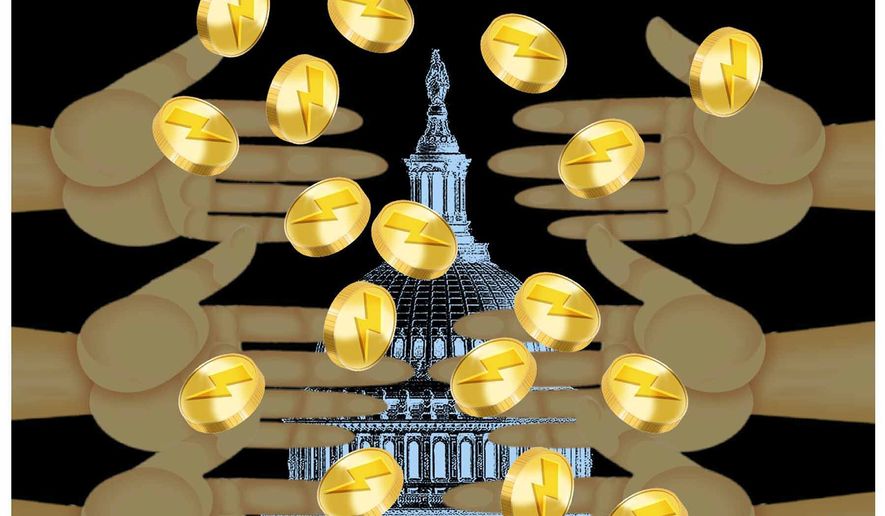OPINION:
The celebrity speculator Sam Bankman-Fried’s single biggest political bet in 2022 was placed on an obscure Democrat running for Oregon’s newly created House seat. Yale Law School grad Carrick Flynn, 36, received a whopping $10 million from Mr. Bankman-Fried’s new Protect Our Future Political Action Committee. It’s the former FTX CEO’s personal Democratic Party campaign fund, which he advertises as preparing the nation for the next pandemic.
Candidate Flynn did not make it out of the nine-way May primary. But that’s not the point. The $28 million PAC’s top 10 recipients were all Democrats in Mr. Bankman-Fried’s strategy of creating a personal aura of virtue for the Democratic Party/liberal media complex to fawn over.
In recent years, he received unctuous PR, opening doors to influencers such as a paid public appearance by former President Bill Clinton at FTX’s Bahamas crypto-coin conference in April. Mr. Bankman-Fried won authentication by CNBC as a digital money guru and won an invite as a speaker by The New York Times to its Manhattan summit of technology leaders.
The Washington Times reviewed Mr. Bankman-Fried’s Federal Election Commission filings for midterm elections. At $40 million, he came in second to currency speculator George Soros in total contributions. But he came in first in mimicking Mr. Soros’ game plan — that is, funding Democrats and their left-wing causes.
Mr. Soros’ portfolio includes defunding the police, installing soft city prosecutors and de facto erasing the southern border. (The latter is President Biden’s favorite way to gain millions of new Democratic voters.)
Mr. Soros has so vaccinated himself against establishment criticism that liberals cry “antisemitism” if the right dares to suggest that what he is doing is not good for America.
Like Mr. Soros, Mr. Bankman-Fried has lathered the Democrats in money as he promotes a climate war and vegan cuisine.
But in the end, the MIT graduate fell hard trying to chase billionaire George Soros. Mr. Soros and his hedge fund churn out plenty of cash for the left, year in and year out. Mr. Bankman-Fried’s FTX cryptocurrency trading exchange crashed into bankruptcy on Nov. 11. A company valued at $32 billion saw billions of dollars disappear.
In 2020, counting FTX and Mr. Bankman-Fried’s co-founded Alameda hedge fund, the two delivered over $11 million to candidate Joseph R. Biden, according to OpenSecrets.org, making the tandem his ninth-largest cash source. OpenSecrets totaled up donations by the two companies and their associates.
FTX’s political expansion would balloon from that point as Mr. Bankman-Fried’s wealth exploded and his industry goals broadened into a brand-new idea for cryptocurrency trading.
For the 2022 midterms, he launched in January his super PAC Protect Our Future and gave it $27 million of the $28 million raised. Outside the PAC, he dished out $13 million to candidates and political groups.
At the same time, his spending on Washington lobbying shot up, too, from $50,000 in 2021 to $640,000 this year, according to OpenSecrets.org.
Why the huge cash uptick? For one, he had a lot more money than in 2020. But Mr. Bankman-Fried also had grand dreams of remaking the $1 trillion global digital coin market, and he would need political help.
That’s why I would argue his PAC handouts looked like run-of-the-mill influence as opposed to some type of noble plan. A sampling: The PAC gave $250,000 to the Oregon Democratic Party.
In addition to his largesse for Mr. Flynn, Mr. Bankman-Fried’s PAC doled out over a million dollars to each of six House Democratic candidates in deep blue districts.
On his personal ledger, Mr. Bankman-Fried sent huge amounts of cash to the Democrats’ House Majority PAC ($6 million); GIM PAC, ($2 million), which promises congressional candidates aligned with his regulatory views; and various Democratic groups such as the DNC Services Corp. and Democratic Grassroots Victory Fund.
As a backdrop, the prince of crypto, as some have dubbed him, staked out an ambitious political agenda in 2022. He wanted to become a regulation revolutionary, and to do it, he dressed up his campaign money as something special — futuristic pandemic protection.
In May, Mr. Bankman-Fried pitched his new world order as a witness before the House Agriculture Committee. It has jurisdiction over commodity trading, and currencies such as his dogecoin are considered commodities, just like gold and oil.
In December 2021, the FTX chief executive formally asked the five-member Commodities Futures Trading Commission to approve a new model for his trading platform. In a nutshell, the plan would allow less collateral when investors borrow from brokers.
By that May, Mr. Bankman-Fried had reached heroic and billionaire status. Bill Clinton had come to his Bahamas home base and appeared with him onstage. And there’s the invite from the powerful New York Times.
Mr. Bankman-Fried assured the House committee, “We have all of the customer protections that exist on traditional futures exchanges.”
What no one knew at the time was that Mr. Bankman-Fried’s Bahamas enterprise may have already started to crumble. It was just months away from financial collapse. And he was running his exchange by the current rules, not his riskier new ones.
On Nov. 11, with his firm now run by a bankrupt CEO, FTX told the trading commission that Mr. Bankman-Fried’s grand plan to become the new father of cryptocurrency was dead. FTX withdrew it.
He has kept tweeting and talking, the latest at that New York Times summit on Nov. 30, where he received a warm welcome befitting a liberal superstar.
“I’ve had a bad month,” he said.
• Rowan Scarborough is a columnist with The Washington Times.




Please read our comment policy before commenting.